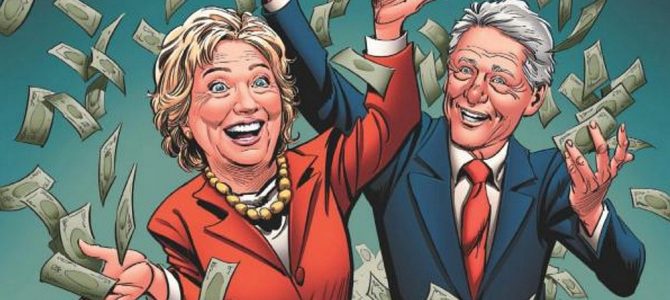
Two weeks ago “Clinton Cash: The Graphic Novel” accomplished an amazing feat by knocking “The Killing Joke,” the origin story of the Joker, out of its 200-week streak of being number one on The New York Times bestseller list. “Clinton Cash: The Graphic Novel” debuted at number one in the hardcover graphic novel category and reached number five overall on Amazon’s bestseller list.
Like the original book by Peter Schweizer, “Clinton Cash: The Graphic Novel” lays out the Clintons’ pattern of corruption. The graphic novel is exposing a wider audience to Schweizer’s research, and if political and media leaders on the Right take notice it could also help them defeat the Left beyond 2016. Here are three lessons from the book’s success.
1. Hire Creative Professionals with Experience Outside Politics
Any time someone suggests that conservatives use creative professionals, they are met with an onslaught of excuses.
“We can just use an intern/staffer who knows Photoshop.”
“We can’t afford a professional.”
“We can’t pay, but you’ll get a ton of exposure.”
“We only hire people who agree with our political philosophy.”
I’ve heard all of these excuses when recommending professional graphic designers, videographers, and artists to right-leaning organizations and media outlets. Certainly, budget is a legitimate consideration. However, I’m reminded of this saying: If you don’t have money to tip, you don’t have money to eat out. If an organization is going to go to the trouble of doing an ad buy on social media or TV or put thousands of dollars into some creative endeavor, they should figure in the cost for professionals.
There are plenty of libertarian and conservative artists. There are also a lot of apolitical or even liberal artists who just want to work and produce good content. Many working writers and artists (not hobbyists supported by other means) don’t care about red or blue. They care about green. Most of us wouldn’t do our day jobs for free, so why do we expect creative professionals to do so?
“Clinton Cash: The Graphic Novel” had a dynamic group of artists who have worked for Marvel and DC Comics, including co-adaptors Chuck Dixon and Brett R. Smith, as well as Sergio Cariello, Don Hudson, Graham Nolan, and Paul Rivoche. Look them up, read their bios, and support their other works. You’ll find no one better.
Not only do you get engaging work when hiring creative professionals, but you’ll also get a new group of folks who will happily promote your content to new audiences.
2. Make a Non-Political Audience Laugh
In college I was obsessed with the now-defunct Suck.com. It was snarky before snarky was cool. Its quirky graphics and writers like Nick Gillespie (who wrote under the pseudonym Mr. Mxyzptlk) were a ray of hope as I trudged passed the earnest wannabe journalists and artists at my liberal arts college.
“Clinton Cash: The Graphic Novel” has that same magic and humor. Schweizer referred to it as a more digestible version of his book. Sure, the dynamic graphics help, but more importantly, it’s funny, entertaining, and educational. These are not empty calories.
I’ve read the graphic novel version a couple times and just flipped through it a couple times more. I always find something new—a funny image in the background, an off-hand remark, a name that’s now familiar as email leaks continue, or a small detail in one of the drawings. It’s what makes classic comedies like “Animal House” and “Caddyshack” still funny after watching them a million times. We still laugh at the jokes we remember and are continually entertained by jokes or details we may have forgotten or missed. Also, if anyone is ripe for the National Lampoon treatment, it’s the Clintons.
Many assume the Left has the upper hand on comedy because “The Daily Show” was once a relative success. Now shows like “Red Eye with Tom Shillue,” “The Greg Gutfeld Show,” and “Kennedy” have become a “safe space” for comedy. Often comedians make the most salient points because they’re living in the culture and entertainment world.
Just like there are hacks in traditional comedy, there are hacks in political comedy. Chief among them are making fun of a candidates’ looks, particularly Hillary Clinton’s or Donald Trump’s. There’s nothing new to be said about cankles or skin tone.
In addition to “Clinton Cash: The Graphic Novel,” another great example of effective use of humor and parody is The Kronies video series.
3. Explore New Mediums
One of the reasons the graphic adaption of “Clinton Cash” appealed to me is because I also wrote a book outside of the traditional norm for the Right. Instead of writing a book critiquing modern dating, I wrote my own personal story in a chick lit-type book. In that same vein, I started a daily email with lifestyle, entertainment, culture, and national news with a great group of women.
Others, particularly those with a broadcast background, have found success with podcasts. Adam Carolla, Joe Rogan, Dave Smith, among many others, have huge followings and credibility, but they aren’t known as political podcasts. They have credibility because listeners know they aren’t spokesmen for one side or another. It’s also important to realize that just because you’re not into a thing (like podcasts, graphic novels, or chick lit books) that doesn’t mean others feel the same way.
If we want to reach out to new audiences, it won’t be through books of platitudes from politicians and media stars or books on the Second Amendment by sexy women or documentaries no one outside the conservative bubble will see. “Clinton Cash: The Graphic Novel’s” success is proof we have an audience hungry for new material delivered in a unique way.









